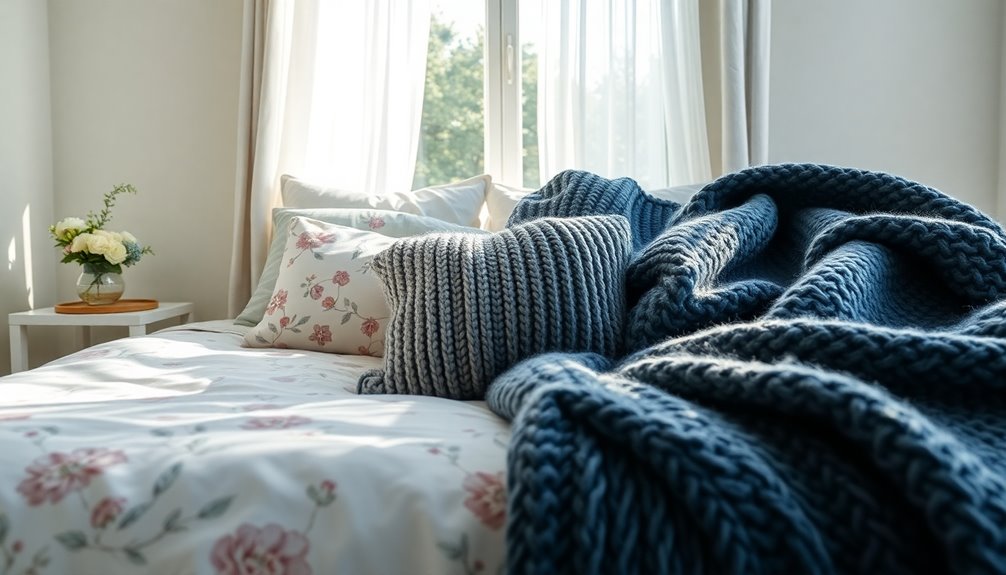When switching between summer and winter bedding, it's important to contemplate fabric weight and warmth. Summer bedding features lighter materials like cotton for breathability, whereas winter bedding often includes thicker options like flannel for insulation. Shifting can be seamless by sorting and storing bedding appropriately. Layering techniques can additionally improve comfort, allowing for adjustment to temperature changes. Choosing the right colors and accessories can create a seasonal atmosphere. There's always more to explore on optimizing your bedding.
Article Highlights
- Sort and clean summer and winter bedding before transitioning to prevent mildew and maintain freshness.
- Use labeled storage bins for easy access and organization of seasonal bedding.
- Layer bedding for flexibility, combining lightweight sheets with breathable blankets in summer and thicker duvets in winter.
- Rotate bedding regularly to prevent wear and tear, ensuring comfort and longevity.
- Incorporate seasonal accessories, like decorative pillows and throw blankets, to refresh your space and create a cozy atmosphere.
Understanding the Differences Between Summer and Winter Bedding

When it comes to selecting bedding, grasping the differences between summer and winter options is vital for a comfortable night's sleep. Summer bedding typically features lighter materials and reduced bedding thickness, allowing for better airflow and temperature regulation. This helps keep sleepers cool during warmer months. Conversely, winter bedding is thicker and often made from materials that provide added warmth, catering to the cold seasonal patterns. The increased thickness traps heat, ensuring a cozy environment on chilly nights. Recognizing these distinctions enables individuals to choose bedding that aligns with their comfort needs throughout the year, promoting restful sleep regardless of seasonal changes. By making informed decisions, one can improve their overall sleeping experience, adapting to both summer and winter demands effectively.
Choosing the Right Materials for Each Season
In the process of selecting bedding materials for different seasons, it is crucial to take into account how they affect comfort and temperature regulation. For summer, lightweight fabrics like cotton or linen provide breathability, promoting seasonal comfort during warmer nights. These materials as well tend to offer excellent durability, guaranteeing they hold up against frequent washing. Conversely, winter bedding often benefits from heavier materials such as flannel or microfiber, which trap heat and provide coziness. These options not just improve warmth but additionally boast material durability, making them suitable for the colder months. By comprehending the unique properties of each fabric, one can ascertain a comfortable sleep environment, customized to the demands of each season.
Tips for Transitioning Your Bedding Seamlessly

Though shifting bedding between seasons may seem intimidating, it can be a straightforward process with a few simple tips. Proper bedding organization and seasonal cleaning can make the change smoother and more efficient.
- Sort and Store: Begin by sorting your summer and winter bedding. Clean items before storing them to prevent mildew and maintain freshness.
- Label Containers: Use labeled storage bins for easy access. This helps in quickly finding what's needed when the seasons change.
- Rotate Regularly: Make it a habit to rotate your bedding every season. This keeps everything in good condition and helps manage wear and tear.
Layering Techniques for Optimal Comfort
When it involves optimizing comfort through layering, choosing the right fabrics for each season is essential. By combining adjustable layers, individuals can easily adapt their bedding to fluctuating temperatures. Furthermore, incorporating temperature regulation techniques can improve sleep quality throughout the year.
Fabric Choices for Seasons
Choosing the right fabrics for seasonal bedding can greatly improve comfort throughout the year. Comprehending fabric durability and aligning with seasonal trends can elevate the sleeping experience. Here are three vital fabric choices:
- Cotton: Lightweight and breathable, cotton is perfect for summer. Its moisture-wicking properties keep sleepers cool.
- Wool: For winter months, wool provides excellent insulation and warmth, making it a cozy choice.
- Bamboo: This versatile fabric works well in both seasons. It's soft, hypoallergenic, and regulates temperature effectively.
Adjustable Layer Combinations
To achieve perfect comfort, layering bedding allows individuals to adjust their sleep environment according to seasonal changes and personal preferences. By utilizing adjustable layer combinations, one can create an inviting space that promotes restful sleep year-round. For summer, lightweight sheets paired with a breathable blanket can provide just the right amount of coverage. Conversely, winter bedding can be improved with thicker duvets and additional throws for extra warmth. This seasonal versatility guarantees that individuals customize their bedding for maximum comfort, easily modifying layers as needed. Incorporating different textures and materials, like cotton and fleece, likewise enriches the sleep experience, catering to specific comfort needs. In the end, this approach nurtures a personalized sanctuary for peaceful nights.
Temperature Regulation Techniques
Though achieving the ideal sleep temperature can be challenging, employing effective temperature regulation techniques can make a significant difference. By comprehending how to balance bedding insulation and airflow, individuals can optimize their comfort throughout the year. Here are three key strategies for temperature control:
- Layering: Use multiple layers of bedding to easily add or remove insulation as needed.
- Material Choice: Opt for breathable fabrics like cotton or linen in summer and warmer materials like flannel in winter.
- Blanket Weight: Select blankets based on the season; lighter options for warmer months and heavier ones for colder nights.
Color and Design Considerations for Seasonal Bedding
When considering color and design for seasonal bedding, it's essential to reflect the mood and ambiance that each season brings. Color psychology plays a significant role here; warm hues like reds and oranges are perfect for winter, evoking coziness and warmth. Conversely, summer bedding often benefits from cooler colors, such as blues and greens, which promote a revitalizing, airy feel.
Incorporating seasonal patterns, like floral designs for summer or snowflakes for winter, adds an extra layer of seasonal charm. These elements not merely improve the aesthetic appeal but additionally create a comforting atmosphere that resonates with the time of year. By thoughtfully selecting colors and designs that align with seasonal themes, one can transform their bedroom into a haven that reflects nature's changes.
Maintaining Your Bedding Throughout the Seasons

Properly maintaining bedding throughout the seasons guarantees longevity and comfort. Regular bedding maintenance is crucial to keep fabrics fresh and inviting. Seasonal cleaning can prevent the buildup of allergens and guarantee a cozy sleep environment. Here are three key steps to take into account:
- Wash Bedding: Aim to wash sheets and pillowcases every one to two weeks, and comforters every month to remove dirt and oils.
- Rotate Bedding: Regularly rotate your bedding to prevent wear and tear. This likewise helps distribute the natural fibers evenly.
- Store Properly: When switching out seasonal bedding, make certain to clean it first and store it in a cool, dry place to avoid mildew.
Budget-Friendly Bedding Swaps for Every Season
In terms of bedding, choosing the right materials for each season doesn't have to break the bank. For summer, lightweight fabrics like cotton or linen can keep things cool, whereas cozy winter layers like flannel or microfiber provide warmth without overspending. With a few simple swaps, anyone can enjoy comfort all year round.
Lightweight Summer Fabrics
As the temperatures rise, choosing lightweight summer fabrics becomes essential for a comfortable night's sleep. Opting for breathable fabrics guarantees better air circulation, helping to keep the body cool. When selecting summer bedding, consider these budget-friendly options:
- Cotton: A classic choice, cotton is soft, breathable, and moisture-wicking, making it ideal for hot nights.
- Linen: Known for its natural cooling properties, linen absorbs moisture effectively and dries quickly, providing a fresh feel.
- Bamboo: This eco-friendly fabric boasts excellent breathability and moisture-wicking capabilities, making it a perfect choice for summer.
Cozy Winter Layers
As summer bedding focuses on breathability, winter layers prioritize warmth and coziness. To create a snug retreat during colder months, one can easily switch to budget-friendly options. Start by layering with thick, snug blankets that trap heat, providing a comforting embrace. Opt for materials like fleece or flannel, which offer warmth without breaking the bank. Adding plush pillows not only improves comfort but likewise adds a touch of style to the bed. Consider using a mix of sizes and textures to create visual interest. Finally, don't forget about a warm duvet or comforter; this crucial piece ties the whole look together. With these simple swaps, anyone can enjoy a cozy winter sanctuary that's both affordable and inviting.
Creating a Cozy Atmosphere With Seasonal Accessories
To create a cozy atmosphere, seasonal accessories play a pivotal role in transforming a space. They add warmth and character, making each season feel special. Here are three fundamental items to contemplate:
- Decorative Pillows: Swapping out pillow covers for those with seasonal patterns or colors can instantly refresh a room's look, providing comfort and style.
- Seasonal Scents: Incorporating candles or diffusers with seasonal scents like cinnamon or fresh pine can evoke the essence of winter or summer, creating an inviting ambiance.
- Textured Throws: Adding a soft, textured throw blanket not just elevates comfort but also adds visual interest to your bedding or sofa.
These elements work together to cultivate a cozy, welcoming environment, customized to the rhythm of the seasons.
Frequently Asked Questions
How Often Should I Change My Bedding Seasonally?
As the seasons dance through the year, changing bedding materials can breathe new life into a bedroom. It's recommended to switch bedding every three months, aligning with seasonal colors that reflect nature's palette. This not just keeps the space fresh but likewise improves comfort. By embracing lighter fabrics in warmer months and cozier options in cooler ones, one can enjoy a serene retreat that resonates with the rhythm of the seasons.
Can I Use the Same Pillows for Both Seasons?
When considering whether to use the same pillows for both seasons, one should think about pillow materials and seasonal comfort. Some materials, like memory foam, can retain heat, making them less suitable for hot summer nights. Meanwhile, cotton or gel-infused pillows might provide better airflow in warmer months. In the end, it's about personal preference and how a pillow feels during different seasons, so experimenting could lead to a more comfortable night's sleep year-round.
What to Do With Off-Season Bedding Storage?
Isn't it a hassle to find space for off-season bedding? To tackle this, one can consider effective bedding organization tips. First, clean the items thoroughly before storing them in breathable bags or bins. Label each container to simplify retrieval later. For seasonal storage solutions, utilizing under-bed space or vacuum-sealed bags can save room. By prioritizing these strategies, one can guarantee their bedding remains fresh and easily accessible, making seasonal shifts smooth and stress-free.
How to Choose Bedding for Transitional Weather?
In the matter of choosing bedding for changing weather, one can utilize layering techniques effectively. Starting with a lightweight base, they can add a medium-weight blanket or quilt for warmth. Fabric choices play an important role; breathable materials like cotton or linen work well for comfort, whereas fleece or flannel can provide added coziness. By mixing and matching these elements, they'll create a versatile bedding arrangement that adapts easily to fluctuating temperatures.
Is It Necessary to Wash Bedding Before Switching Seasons?
When considering whether to wash bedding before changing seasons, it's crucial to prioritize bedding hygiene. Regular washing guarantees that dust mites, allergens, and bacteria are removed, promoting a healthier sleep environment. Furthermore, fresh linens contribute to seasonal freshness, making the change more enjoyable. So, although it might not be strictly necessary, giving bedding a good wash before changing seasons can improve comfort and cleanliness, ultimately boosting one's overall sleep quality.













